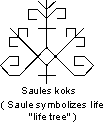|
Sun Tree ( Saules Koks )
[Sun’s tree]. Also called dzīvības koks [life tree]
It represents life cycle, from birth to death.
- Sauļotais stabs. [sun pole]
- There is a circle in the middle, the top and bottom are symmetric opposite triangles.
- It parallels a tree structure we see in nature. The tree trunk has branches coming out from it, and it has branches (roots) underground, grounding and symmetrically opposing the branches above ground. So the stronger the foundations, the stronger the tree.
Our esma/psyche works on the same principles, and hence all the dieva sēta. The center circle is our saulīte, the part inside us that always shines. From there we begin to grow, both in our foundations, and in the end result of what we have accomplished with our lives. Diž [suffix -largely integrated] This is our goal. It is our liktenis that can help us build our own saules koks into what we like, within our dieva sēta. If we make solid foundations within our brain, our inner reality, then it will transfer to our outer reality.
Sauļotais stabs diagram. This pole is often sculpted in architecture.
Saules koks symbol is what we see in the end.


Trees in nature as saules koks
Trees representing time:
- Oak tree - Leap year:
- In the story of the sun , the sun cries when picking branches of oak tree that was struck by Pērkons [Thunder] during wedding ceremony. Sun picks up every branch, but the one on top, which she finds on the 4th leap year.
- Birch tree - Day cycle:
- 3 leaves or branches. Representing where sun rises and sets. The middle is used by Dievs or Saule to melt silver. So during the day we can use our sparkling resources to construct things, for better or for worse.
Trees representing life in nature:
- Green tree - green is young growth.
- Red tree - red is ripe.
- Is where the sun rises in the morning (represents the beginning of life).
- Young men go to look for it, but in vain, turning into old men (only women can get near red tree because life begins inside them). A red woman is fertile (Es meitiņa kā rozīte, kā sarkana zemenīte) [As a girl, like a rose, like a red berry – all said in diminutive].
White trees representing the balanced psyche.
- Ābele [apple tree].
- Its flowers in spring are white, and then they change structure into apples in fall. Means that your white esma (white flower) is best to create a living structure on earth (apple).
- Bērzs [birch]
- In Latvia birches are very tall, straight stemmed trees. Hence they symbolize stability. They are white, symbolizing well balance. A bērzu birze [birch cluster] is a popular place to go for spiritual comfort.
Trees used by dieviņi when they want to talk with us.
- Liepa [Linden]
- Laima sits here.
- In Latvia, the Linden is a generic looking tree. It can grow simply or quite large and intricately.
- Vītols [Willow]
- Māra sits here.
- In Latvia, a willow grows by calm water, and has silvery leaves with somewhat droopy branches. Earth, water, and consequent growth of tree is symbolic of principles of growth. Its sparkling leaves are symbolic of spiritual growth. Its long wavy branches can be seen to comfort you as a mother hugging a child.
The integrated dižais tree
- Ozols [Oak]
- In Latvia, this tree grows very intricately.
- A job well done.
- An oak wreath is presented to someone, male or female, who has done something requiring tenacity and integrated wellness.
- The wise one.
- An oak tree is very integrated and therefore wise. It is a popular place to go when seeking out answers to life’s questions.
- The man tree.
- A man wants to have many skills to work in a sēta. The oak tree represents a skillful man.
- In folklore bees or zīles [acorns] right on tree show that woman find this attractive. Bees, honey, zīles, amber and anything yellow are like yolk, representing potential procreation.
- The man’s fighting instinct can be both constructive and destructive. Pērkons [Thunder] often lashes out at the oak tree, causing much damage, but sometimes in its place there is dzintars [amber] which represents potential new growth for the better.
SSS2004 Home
|